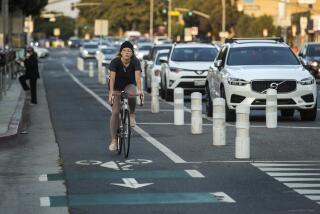Broad View on Traffic
- Share via
A week ago, the Los Angeles City Council called for a comprehensive plan to unclog the congested Ventura Freeway, the San Fernando Valley’s main east-west artery.
A few days later, the Metropolitan Transportation Authority told Valley business leaders it was considering building a high-speed busway along the abandoned Burbank-Chandler railroad corridor.
Is the MTA proposal the answer to cross-Valley congestion?
A busway or light rail system, which the MTA is also considering, would not magically empty the Ventura Freeway. But it would offer an alternative route across the Valley and provide a connection to the North Hollywood Metro Red Line station, scheduled to open in June.
Or it would if there were money to build such a link.
What money the MTA has not squandered through years of mismanagement and neglect it has committed to funding mass transit alternatives to subways that had originally been planned for the Eastside and Mid-City. That is only fair. The Valley, after all, got its subway.
But Los Angeles County Supervisor Zev Yaroslavsky, who led the drive to effectively kill further subway funding, believes the MTA is still thinking in subway dollars. If the Eastside and Mid-City adopted less expensive alternatives--Yaroslavsky is a big fan of the high-speed busways--there would be enough money for the Valley as well.
But busways are only part of the solution. Yaroslavsky and other city leaders, including Mayor Richard Riordan, became intrigued by busways after seeing how well they worked in Curitiba, Brazil. As key to Curitiba’s success in its war against congestion is a war against urban sprawl. A strict 30-year master development plan puts housing, jobs and transportation lines within easy reach of each other.
Significantly reducing traffic on the Ventura Freeway, like reducing congestion throughout the Los Angeles area, calls for a comprehensive response: new roads, additional traffic and turn lanes, more mass transit, “smart” fare cards, better traffic signals and a balance of jobs, housing and transportation.
And it calls for a regional response--which holds true whether the Valley remains under the MTA or forms its own bus system.
More to Read
Sign up for Essential California
The most important California stories and recommendations in your inbox every morning.
You may occasionally receive promotional content from the Los Angeles Times.












